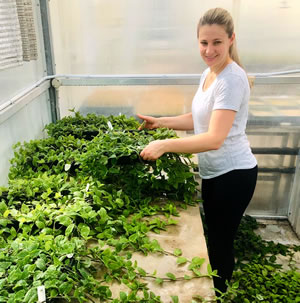Welcome Simone Cunha
 We are very pleased to introduce a PhD student from Brazil, Simone Cunha, who has been registered at the University of Canterbury since early 2019. The main aim of Simone’s PhD research is to investigate the impact of the four biocontrol agents that have been released against tradescantia (Tradescantia fluminensis) in New Zealand. She will also measure the interactions among the biocontrol agents in order to understand whether the four agents are complementary. “I have always been interested in studying botany and interactions between plants and animals, especially in the conservation field,” said Simone.
We are very pleased to introduce a PhD student from Brazil, Simone Cunha, who has been registered at the University of Canterbury since early 2019. The main aim of Simone’s PhD research is to investigate the impact of the four biocontrol agents that have been released against tradescantia (Tradescantia fluminensis) in New Zealand. She will also measure the interactions among the biocontrol agents in order to understand whether the four agents are complementary. “I have always been interested in studying botany and interactions between plants and animals, especially in the conservation field,” said Simone.
Tradescantia is a trailing, perennial groundcover with soft, creeping stems that is native to the forests of south and southeastern Brazil and the north-east of Argentina. Tradescantia was introduced to New Zealand as an ornamental in 1910, but quickly escaped garden cultivation to invade a variety of damp, shaded habitats such as forests, shrublands, riparian zones, fernlands and wetlands. Dense mats of the weed inhibit the growth of seedlings of native plants, even smothering and suppressing small plants. Tradescantia is widespread throughout New Zealand, but in areas prone to frost it is restricted to sheltered habitats. Although tradescantia does not produce seeds in New Zealand, a plant fragment with a node has a high probability of survival and regrowth, giving rise to new plants.
Three species of beetle and one plant pathogen have been released as biocontrol agents for tradescantia in New Zealand, and all four agents have established to varying degrees in different parts of the country. Adult beetles of all three species feed on the leaves of tradescantia, while the larvae of each species attack different plant parts, and they are therefore expected to be complementary overall. Larvae of the tradescantia leaf beetle (Neolema ogloblini) damage the foliage, larvae of the stem beetle (Lema basicostata) bore into the stems, and larvae of the tradescantia tip beetle (Neolema abbreviata) feed on the growing shoot tips. The yellow leaf spot fungus (Kordyana brasiliensis), which is the most recent agent to be released, infects the leaves of tradescantia, sometimes leading to defoliation.
Simone will set up controlled glasshouse experiments at the university to investigate interactions between the four biocontrol agents. “I will be testing different combinations and densities of the agents to assess synergistic or antagonistic interactions between them” explained Simone. “For example, while the damage of some of the agents is expected to be complementary, leading to greater impacts on the weed, the tradescantia tip beetle reduces leaf production, which could reduce local densities of the leaf beetle, altering damage levels to the weed”. Simone also plans to run experiments outdoors, where natural weather conditions may limit the growth of tradescantia and the performance of the biocontrol agents. Lastly, Simone will study population densities and the impact of the agents where they have established or are soon to be released in Canterbury. “I hope my research will contribute to an understanding of how best to manage releases of the tradescantia biocontrol agents, and to a broader understanding of how to improve the efficiency of biocontrol programmes in New Zealand,” said Simone.
Simone’s PhD project is self-funded. She is being supervised by Prof. Dave Kelly (University of Canterbury) and Simon Fowler (MWLR).
